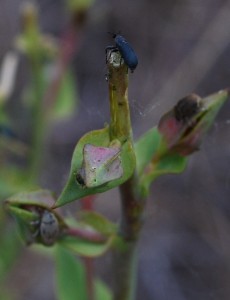Stephens, AEA, DS Srivastava and JH Myers (2013) Strength in numbers? Effects of multiple natural enemy species on plant performance. Proceedings of the Royal Society B, 280: 20122756.
While plants are invariably attacked by numerous insects and pathogens, the consequences of multiple enemies for plant performance are poorly understood. In particular, a predictive framework is lacking for when to expect enemies to have independent versus non-independent effects on their host plant. This is problematic for weed biological control programmes where multiple enemies are frequently released with the possibility of antagonistic interactions that may reduce control.
Here, we conduct an analysis of 74 unique plant–enemy–enemy combinations from 51 studies to determine the frequency of non-independent effects of natural enemies on host plant performance, and test a number of a priori predictions for determinants of independent and antagonistic effects of multiple enemies. For three-quarters of plant response measurements, enemies had independent effects on plant performance. In most of the remainder, multiple enemies led to less reduction in performance than that predicted from each enemy alone. Antagonistic effects occurred when enemies attacked the same plant part concurrently or attacked plant reproductive structures. These two predictors explained why antagonistic effects were particularly prevalent for weeds, plants in the family Asteraceae and enemies in the order Diptera. Our results suggest that a few simple rules about avoiding particular combinations of multiple enemies could improve biological control success.

